
Home » Carve » Experience » Getting Started » Workspaces » In the Studio with Hot Water
By Dan Michael, reprinted from Sculpture NorthWest March/April 2004
February in our Northwest is predictable: sun, clouds, wind, rain, maybe all in the same day or hour. Temperature, too, is all over the place, generally hanging around 40F somewhere. I usually bundle up in raingear, working out under the trees rather than abusing my privileges in the garage. Once the gloves, goggles, respirator and earmuffs are on, it is easy to get lost in the stone world and forget about the weather. There does come a time in the process for sanding and finishing, usually with water to lubricate and clear away particulates.

Maybe I’m getting soft or lacking passion, but for whatever reason, the water seems colder these days. It generally comes out the tap around 45-50F degrees. After about 15 minutes in that environment the imagination gives way to reality and fingers don’t function like they should. Gloves are generally cumbersome and sweaty, but sometimes the disposable blue nitrile’s give a little protection from abrasion without much loss in sensitivity. They don’t keep hands warm. I recall talking with Stu Jacobsen about this in the past; he installed a hot water tank in his studio to reduce pain and suffering. Unfortunately, my outdoor studio doesn’t have a secure space for the tank, nor the electrical capacity for heating. The garage is 75 ft away, so temperature losses would be too great to install the tank there.
I followed Dave Haslett’s example and brought a small piece down to the house and sanded in the kitchen sink. Warm? Yes. Inconvenient and destructive to sink and countertop finishes? Yes. Provoke outbursts of disapproval from house- holders not obsessed with the joy of stone sculpture? Yes. You get the idea? I quickly shut off my fantasy of plunging a rather large sculpture into the hot tub for a somewhat lengthy period of hand sanding.
Insight occurred during a stroll through the local homeowners’ warehouse store. Still dreaming about the hot tub no doubt, I wandered down the aisle where the water heaters lived. There sat this cute little white cylinder about a foot and a half tall, with a standard three-prong power cord coming out the side. A two-and-a-half-gallon Point Of Service water heater is meant for remote bathrooms, where there is not a demand for large quantities of hot water, i.e., no tub or shower and there would be significant heat loss running the normal hot water system that distance. The POS heater uses 115 vac, at about 12 amps. This means it could be plugged into a standard 12 AWG extension cord without overloading the circuit. Flash, flash, buy it. I did for $130.
I used ½ inch pipefittings with a female hose coupling to the inlet (cold water) side and a standard ½ inch hose bib faucet to the outlet (hot water). I also put ¾ inch pipe on the blow off valve to divert any discharge downward. Hook up a garden hose to the inlet, plug it in, warm water comes out the hose bib. A flag raised, questioning what occurs if someone plugs in the unit before it fills with water. There is a thermostat that automatically controls the heater element, but the tank needs to be full of water for that to work properly.
I installed a low-pressure cutout switch ($30) on the inlet side and wired the power cord in series. These are standard controls for water pumps, meant to shut off a pump when a well runs dry, and prevent burning up pumps. Now the heater will not come on until the tank fills and there is 20 lbs. water pressure on the supply hose.
I set the thermostat as low as it would go, 90F. Use a long hose on the supply side to bring the tank out to the work site. Then use a short 10 ft hose on the hot water side to reduce heat loss (it is not a very efficient space heater). Plug in the extension cord. It takes me about fifteen minutes to gather and haul tools from the garage to the studio area. The water is usually hot by this time. The 2½ gallon unit is adequate for one person hand sanding or using small power tools with center water feed or side jets.
The wind still howls, and the rain still comes in sideways. Turn on the water. Start sanding. Tropical 90F water flowing over the fingers, maybe some slack key playing through the headphones… ahh, stone sculptor reverie, where will it take me next?
Some simple calculations for the numbers enthusiasts:
Maintainable flow through tank at 90F is 82 Btu/min / 350 Btu/gal = .23 gal/min (roughly 1 qt per min)
Using water at a rate greater than this would cause the water to slowly get cooler because the heater can’t add enough energy to the cold water. I measured start and stop temperatures and timed the duration of the startup heat cycle. It was within 10% of calculated, way close for studio work.

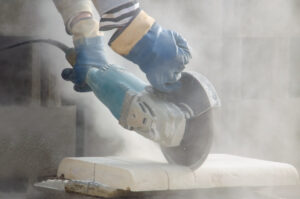
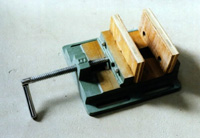

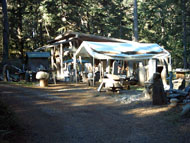

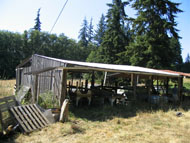
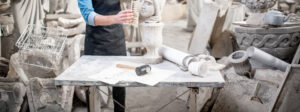

We need some kind of descriptive text here.